1.1 Interchangeability
In modern production, when large quantities of parts are made to be assembled with other parts, it is necessary to make the parts so that any part will fit into plane without further machine or hand work. This is called the interchangeability of parts and some examples are shown in Fig.1-1.
Definition
It is the performance with which a group parts of the same size can be replaced each other.
Classification
Interchangeability can be divided into two types, i.e., complete interchangeability and incomplete interchangeability, according to the change extent.
Complete interchangeability: in an assembly, any auxiliary options and repair are not needed.
Incomplete interchangeability: in an assembly, selection (pre-grouping) and adjustment are permitted such as roller bearings.
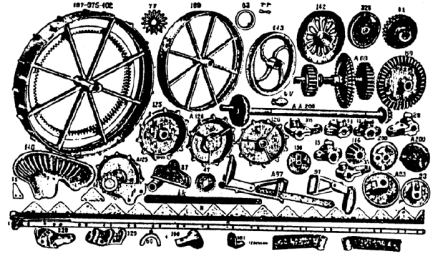
Figure1-1 Examples of Interchangeability
1.2 Series of Preferred Values
Whilst it is possible to buy custom passive components with any desired value, standard parts are manufactured in ranges of preferred values. The reason behind this is that the manufacture method of many components results in a spread of characteristics and it is expensive to make/select the accurate values, whilst most components will work adequately with loose tolerance parts. It makes good economic sense to make and stock only a limited range of values.
In the 1870s, a French army officer, Colonel Charles Renard, tried to rationalize the procurement of ropes for use with military balloons! He derived a preferred number system (the ‘Renard system’) using a geometric progression based on the number 10. The numbers created from the 5th (10th, 20th, 40th . . . ) root of 10, rounded off to one/two decimal places, created the R5 (R10, R20, R40, R80 . . . ) series. R5, R10, R20, and R40 are the basic series, and R80 is the additional series. Series of preferred values are the decimal geometric series and their common ratio can be calculated as
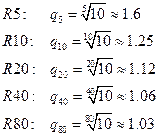 (1-1)
(1-1)
The most basic R5 series consists of these five rounded numbers:
R5: 1.00 1.60 2.50 4.00 6.30
Example1:
If our design constraints tell us that the two screws in our gadget should be placed between 32 mm and 55 mm apart, we make it 40 mm, because 4 is in the R5 series of preferred numbers.
Example2:
If you want to produce a set of nails with lengths between roughly 15 and 300 mm, then the application of the R5 series would lead to a product repertoire of 16 mm, 25 mm, 40 mm, 63 mm, 100 mm, 160 mm, and 250 mm long nails.
If a finer resolution is needed, another five numbers are added to the series, one after each of the original R5 numbers, and we end up with the R10 series:
R10: 1.00 1.25 1.60 2.00 2.50 3.15 4.00 5.00 6.30 8.00
Where an even finer grading is needed, the R20, R40, and R80 series can be applied:
R20: 1.00 1.25 1.60 2.00 2.50 3.15 4.00 5.00 6.30 8.00
1.12 1.40 1.80 2.24 2.80 3.55 4.50 5.60 7.10 9.00
R40: 1.00 1.25 1.60 2.00 2.50 3.15 4.00 5.00 6.30 8.00
1.06 1.32 1.70 2.12 2.65 3.35 4.25 5.30 6.70 8.50
1.12 1.40 1.80 2.24 2.80 3.55 4.50 5.60 7.10 9.00
1.18 1.50 1.90 2.36 3.00 3.75 4.75 6.00 7.50 9.50
R80: 1.00 1.25 1.60 2.00 2.50 3.15 4.00 5.00 6.30 8.00
1.03 1.28 1.65 2.06 2.58 3.25 4.12 5.15 6.50 8.25
1.06 1.32 1.70 2.12 2.65 3.35 4.25 5.30 6.70 8.50
1.09 1.36 1.75 2.18 2.72 3.45 4.37 5.45 6.90 8.75
1.12 1.40 1.80 2.24 2.80 3.55 4.50 5.60 7.10 9.00
1.15 1.45 1.85 2.30 2.90 3.65 4.62 5.80 7.30 9.25
1.18 1.50 1.90 2.36 3.00 3.75 4.75 6.00 7.50 9.50
1.22 1.55 1.95 2.43 3.07 3.87 4.87 6.15 7.75 9.75
1.3 Tolerance
1.3.1 Definition
A tolerance indicates that the total permissible deviation of a size and is also equal to the difference between the limits of size. For example, a hole dimension shown in Fig.1-2(a) and given as ![]() means that the dimension of manufactured part may be varied between 1.250 mm and 1.251mm. Its tolerance is 0.001mm. Another example is shown in Fig.1-2(b) where the shaft dimension is given as
means that the dimension of manufactured part may be varied between 1.250 mm and 1.251mm. Its tolerance is 0.001mm. Another example is shown in Fig.1-2(b) where the shaft dimension is given as ![]() , the dimension of manufactured part may be varied between 1.247 mm and 1.248mm, and its tolerance is 0.001mm.
, the dimension of manufactured part may be varied between 1.247 mm and 1.248mm, and its tolerance is 0.001mm.
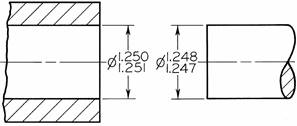
(a) (b)
Figure 1-2 Tolerance Examples
1.3.2 Necessity of Tolerance
It is almost impossible (and sometimes uneconomical) to maintain the strict degree of accuracy as listed on a plan. To accommodate this, it is normal to display measurements with a plus or minus (+/-) tolerance which allows for some margin of error. Care needs to be taken however when determining such +/- tolerance, particularly where there are mating parts. For example, a shaft which is machined to its maximum tolerance may not fit a gear center that has been machined to it minimum tolerance or an unsatisfactory loose fit would result from the shaft being machined to its minimum tolerance with the gear center machined to its maximum tolerance. Usually, the tolerance is decided at the design stage and a machinist must take care to apply the required dimensional tolerance and to ensure that discrepancies are not introduced as a result of poor workmanship of measuring techniques.
Example1:
Fig. 1-3 shows the plans of a fish robot's joint. In the plan, a shaft is inserted in the holes of Parts 1 and 2. The diameter of the holes is required to be on the plus-side of the dimensional deviation, and the diameter of the shaft is required minus-side of the dimensional deviation. Part 2 is inserted a slot of Part 1. Then the slot of Part 1 must have a plus-side dimensional deviation, and the size of Part 2 must have a minus-side dimensional deviation.
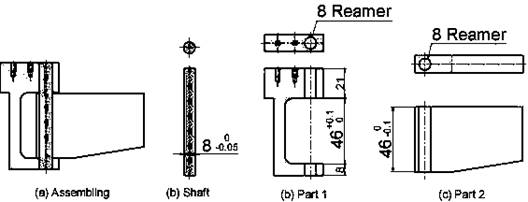
Figure 1-3 Tolerance of a Shaft and Holes
Example2:
Many machines have bearings that support a rotating shaft as shown in Fig.1-4. Various standardized bearings are commercially available and easily obtained. Generally, the outer diameter of a bearing has a minus-side dimensional deviation. The hole for the bearing must be finished to a plus-side dimensional deviation. On the other hand, the inner diameter of a bearing is a plus-side dimensional deviation, then the shaft to be inserted into the bearing must be finished to the minus-side dimensional deviation.
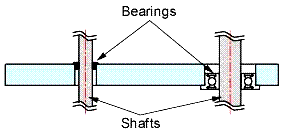
Figure 1-4 Installation of a Bearing
Example3:
An O-ring is a mechanical component which is used as a seal device for various fluids as shown in Fig.1-5. In order that it should work correctly, a slot of the O-ring must be finished to required tolerance which is shown in typical O-ring catalogues.
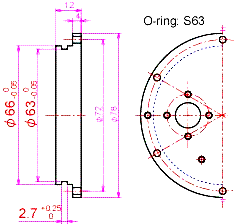
Figure 1-5 A Slot for an O-Ring
Examaple4:
In some special cases, as exampled below, a minus sided dimensional deviation is required: Fig.1-6 shows a one-way clutch fitted with bearings and a shaft. In order to obtain the correct operation, the outer ring of the one-way clutch must mate firmly with it mating hole. To achieve this, the hole needs to be finished on the minus-side of the dimensional deviation. In this case, the hole was finished with a hand reamer of 11.98 mm diameter, though the nominal dimension of the one-way clutch is 12 mm.
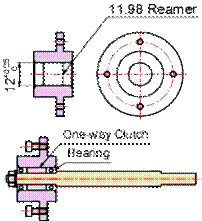
Figure 1-6 Installation of a One-Way Clutch
Source: http://ime.djtu.edu.cn/upload/pictures201011/101118131100bb17faa332595b31.doc
Web site to visit: http://ime.djtu.edu.cn/
Author of the text: indicated on the source document of the above text
If you are the author of the text above and you not agree to share your knowledge for teaching, research, scholarship (for fair use as indicated in the United States copyrigh low) please send us an e-mail and we will remove your text quickly. Fair use is a limitation and exception to the exclusive right granted by copyright law to the author of a creative work. In United States copyright law, fair use is a doctrine that permits limited use of copyrighted material without acquiring permission from the rights holders. Examples of fair use include commentary, search engines, criticism, news reporting, research, teaching, library archiving and scholarship. It provides for the legal, unlicensed citation or incorporation of copyrighted material in another author's work under a four-factor balancing test. (source: http://en.wikipedia.org/wiki/Fair_use)
The information of medicine and health contained in the site are of a general nature and purpose which is purely informative and for this reason may not replace in any case, the council of a doctor or a qualified entity legally to the profession.
The texts are the property of their respective authors and we thank them for giving us the opportunity to share for free to students, teachers and users of the Web their texts will used only for illustrative educational and scientific purposes only.
All the information in our site are given for nonprofit educational purposes